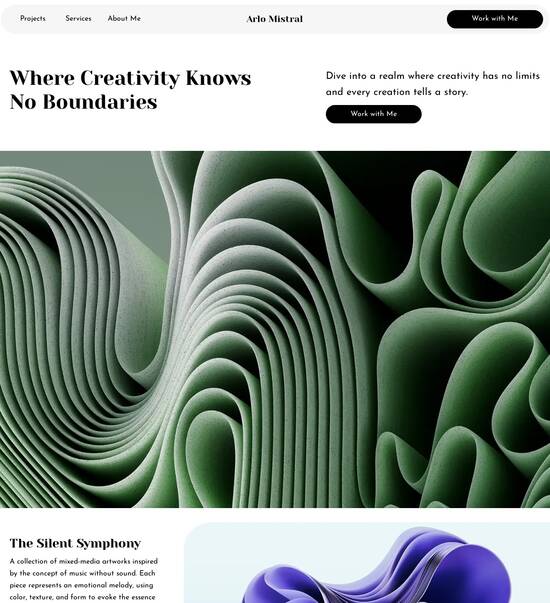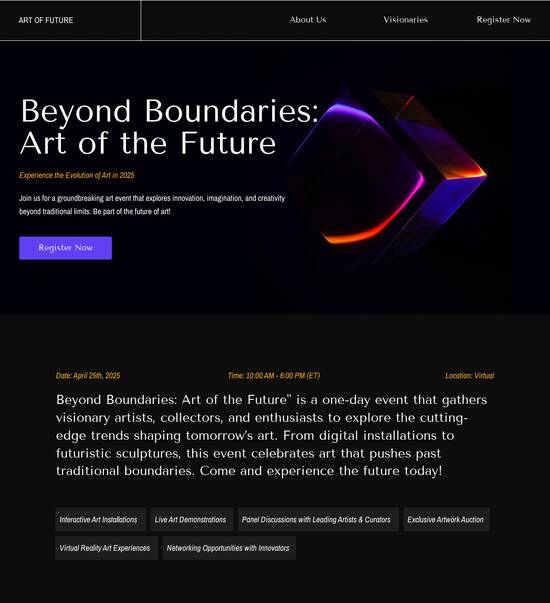
Next.js optimized CRM website template
Explore Similar TemplatesAbout template
Leverage our intuitive page builder and high-converting Next.js optimized CRM website template.
Recommended templates

Easy to build without coding
With the intuitive drag-and-drop builder, anyone on your team can create high-converting pages without any knowledge of code or design. Make enhancements to your landing page with custom widgets using Javascript, HTML/CSS, or third-party scripts.

Multiple layouts for any industry and goal
Select from 500+ landing page layouts built to boost conversions across industry-specific scenarios. Customize them by adjusting fonts, adding images, and generating on-brand content with the AI assistant. Quickly scale with Instablocks® and Global Blocks that you can save, reuse, and update globally.

Loads fast and looks polished on any device
Every template is responsive, which means they present professionally on any device and load blazingly fast with our Thor Render Engine. You can also power them up with Google AMP technology to deliver an unparalleled mobile experience and drive higher conversions.

Robust analytics & experimentation
Get real-time updates and reporting across all your devices, showing the number of visitors, conversions, cost-per-visitor, and cost-per-lead. Launch AI-powered experiments, run A/B tests, and use heatmaps to analyze user behavior, then optimize your landing page to maximize conversions.







Easy to build without coding
With the intuitive drag-and-drop builder, anyone on your team can create high-converting pages without any knowledge of code or design. Make enhancements to your landing page with custom widgets using Javascript, HTML/CSS, or third-party scripts.
Multiple layouts for any industry and goal
Select from 500+ landing page layouts built to boost conversions across industry-specific scenarios. Customize them by adjusting fonts, adding images, and generating on-brand content with the AI assistant. Quickly scale with Instablocks® and Global Blocks that you can save, reuse, and update globally.
Loads fast and looks polished on any device
Every template is responsive, which means they present professionally on any device and load blazingly fast with our Thor Render Engine.
Robust analytics & experimentation
Get real-time updates and reporting across all your devices, showing the number of visitors, conversions, cost-per-visitor, and cost-per-lead. Launch AI-powered experiments, run A/B tests, and use heatmaps to analyze user behavior, then optimize your landing page to maximize conversions.
All the features you need to build nextjs crm template
Explore more featuresLearn how to build next js crm
Frequently asked questions about crm nextjs
Leading the way in building high-performing landing pages





Crm next js: Your ultimate how-to guide
Instapage is the leading platform for creating high-converting landing pages, specifically designed for marketers looking to boost their campaigns. Utilizing a template-driven approach, Instapage allows users to quickly build pages that capture leads and drive engagement. This guide will explore the step-by-step process of using Instapage effectively to maximize your digital marketing ROI.
Understanding the power of landing pages
Landing pages are integral to converting visitors into leads and customers. With Instapage, you gain access to over 100 customizable templates that cater to various industries. These templates are specifically designed with conversion in mind, ensuring your marketing efforts translate effectively into measurable results.
- High-converting templates: Pre-built layouts ensure your landing pages are optimized for performance.
- User-friendly interface: No coding skills are required, allowing non-tech-savvy marketers to create stunning pages.
- Real-time collaboration: Easily share designs and gather feedback from team members and stakeholders.
Creating your first landing page
To get started with Instapage, follow these simple steps to create your first landing page that captures leads effectively.
- Select a template: Choose a template that aligns with your campaign's goals or industry.
- Customize the design: Use the drag-and-drop builder to tailor widgets, text, and images as needed.
- Set up integrations: Connect forms to your email marketing tools or CRMs to streamline lead generation.
Optimizing for conversions
Once your landing page is set, it's vital to optimize it for maximum conversions. Instapage provides several tools to aid this process.
- A/B testing: Create multiple versions of your page to see which performs better in attracting leads.
- Heatmaps: Analyze visitor interactions on your page to understand what captures their attention.
- Analytics dashboard: Use built-in analytics to track performance metrics and refine your strategy.
These features not only enhance your page's effectiveness but also provide invaluable data to inform future campaigns.
Applying these strategies through Instapage can lead to significant improvements in lead generation and conversion rates.
Ready to elevate your digital marketing efforts? Start utilizing Instapage today and discover how easy it is to create impactful landing pages that truly engage your audience.
The evolution of CRM websites: harnessing Next.js for optimization
Understanding the foundation of Next.js and CRM integration
Next.js is a powerful framework built on top of React, designed to enable developers to create high-performance websites efficiently. Its capabilities include server-side rendering, static site generation, and the ability to create dynamic web applications with minimal hassle. With features such as automatic code splitting and optimized bundling, Next.js ensures that users experience faster load times and improved performance. This makes it an attractive option for businesses looking to improve their online presence.
When integrated with Customer Relationship Management (CRM) systems, Next.js can take these capabilities even further. CRM systems play a crucial role in managing customer interactions, tracking sales, and streamlining operations. By enhancing CRM functionalities with Next.js, businesses can benefit from better user experiences and more robust performance.
Key features of Next.js optimized CRM templates
One of the standout features of Next.js is its ability to handle dynamic routing and page generation, which is essential for CRM websites that require users to navigate through various data points. The framework offers flexibility in managing both static and dynamic content, allowing developers to build pages that can be generated at runtime when needed. This is particularly beneficial for CRM systems where data frequently changes and real-time updates are necessary.
SEO is another critical aspect to consider in CRM visibility. Next.js templates are inherently optimized for search engines due to their built-in features. Automatic pre-rendering capabilities ensure that search engines can easily crawl the content, improving the chances of higher rankings. This is vital for businesses that rely on online presence and visibility to attract customers.
Unique aspects of Next.js templates for CRM websites
Next.js offers a variety of ready-to-use admin templates that are perfect for managing customer relationships efficiently. These templates come equipped with a user-friendly interface and essential functionalities, such as analytics dashboards, data visualization tools, and user management systems. The streamlined design of these templates allows teams to focus on what matters most—building relationships with customers and driving successful outcomes.
Another unique aspect is the customization capabilities of Next.js templates. Developers can easily modify existing components or create new ones to tailor the user experience according to the specific needs of their audience. For instance, businesses can implement personalized dashboards that display relevant data for individual users, improving user engagement and satisfaction. Real-world examples include SaaS companies that utilize Next.js to integrate their CRM systems seamlessly, increasing user retention.
The development process: building your CRM website with Next.js
Setting up a Next.js CRM template is a straightforward process that starts with choosing the right template to suit your business needs. After selecting a template that aligns with your brand and functionality requirements, installation often involves running a simple command and configuring any necessary settings. Many templates come with detailed documentation, making it easier for developers to get started. Following a well-structured setup process ensures a smooth development experience.
Utilizing Next.js features effectively during development can really optimize your CRM website's functionality. For example, implementing API routes allows developers to easily manage data retrieval processes for various CRM features. Additionally, understanding and leveraging Server-Side Rendering (SSR) can greatly impact the overall performance of the website, as it allows pages to load faster and enhances the user experience.
Empowering developers: features that simplify CRM customization
The component-based architecture of Next.js simplifies development by allowing developers to create reusable UI components. This modular approach not only enhances maintainability but also speeds up the development process. By using React components, developers can focus on building efficient and scalable applications without having to rewrite code for similar elements—ensuring consistency across the CRM platform.
Additionally, Next.js offers built-in support for both TypeScript and JavaScript. TypeScript provides type safety and enhances code quality, which is especially beneficial in large codebases often associated with CRM systems. This integrated approach allows developers to manage their projects more efficiently, leading to fewer errors and a smoother development process.
Global accessibility: RTL and multilingual support
With an increasingly diverse user base, implementing RTL (Right-To-Left) language support is crucial for businesses aiming for inclusivity. Next.js templates facilitate RTL support effectively, allowing developers to build interfaces that cater to Arabic, Hebrew, and Farsi speakers. This ensures that CRM platforms are accessible and user-friendly for all, fostering a broader customer reach.
Furthermore, multi-language capabilities are essential for creating CRM experiences that accommodate various linguistic groups. Tools and libraries like i18next and Next.js's own internationalization support allow developers to seamlessly integrate multiple languages, enhancing user satisfaction and ensuring all customers feel valued. This strategic approach to localization can significantly bolster a CRM's effectiveness in global markets.
Exploration of rich template libraries in Next.js
Next.js has a diverse range of template libraries, making it easier for developers to find tailored solutions for CRM websites. Popular offerings often include templates designed for various purposes, such as admin dashboards, landing pages, and user management portals. This vast selection allows businesses to choose a template that aligns not only with their operational needs but also with their branding strategies.
When selecting a template, it's essential to consider factors such as performance, usability, and support options. By comparing different offerings, businesses can make informed decisions based on which templates fulfill their specific requirements, leading to a more efficient implementation process. Investing time in this selection can pay off in terms of user experience and operational efficiency.
Harnessing documentation for seamless development
The Next.js documentation serves as a crucial tool for developers embarking on building CRM websites. Key sections such as API routes, dynamic routing, and static site generation equip developers with the knowledge they need to maximize the framework's capabilities. Following best practices outlined in the documentation can avoid common pitfalls and streamline the development process.
Integrating CRM-specific documentation with Next.js resources can significantly impact project success. A cohesive knowledge base ensures that developers have the necessary guidance for both the framework and CRM functionalities, allowing for a smoother workflow. Maintaining this documentation is vital for long-term reference and training new developers on the team.
Analyzing the benefits of using Next.js for CRM websites
Using Next.js for CRM websites brings substantial performance enhancements. With faster load times, users are more likely to engage with the platform, leading to improved customer retention. Research has shown that speed plays a significant role in users’ willingness to adopt new solutions, highlighting the importance of optimizing performance for CRM systems.
Moreover, Next.js optimized templates can be cost-effective in the long run. Businesses can reduce overhead by choosing well-structured templates that require less ongoing maintenance and development effort. These long-term financial benefits encourage companies to invest in Next.js solutions that provide tangible returns on their investment.
Case studies: real-world applications of Next.js in CRM development
Many notable companies have successfully implemented Next.js in their CRM solutions. By highlighting these success stories, businesses can gain insight into the practical benefits of using Next.js. These case studies often illustrate metrics such as increased user engagement, reduced bounce rates, and improved conversion rates — clear indicators of the framework's effectiveness.
User testimonials and expert opinions further enrich the understanding of Next.js's impact on CRM systems. Gathering insights from developers and end-users helps paint a clearer picture of both the practical applications and perceived value of the framework, providing a comprehensive view of its advantages in real-world scenarios.
Future trends: Next.js and CRM innovations
The evolution of CRM solutions is closely tied to emerging technologies, including artificial intelligence and machine learning. As these technologies continue to grow, they will likely create new opportunities for CRM enhancements through Next.js. Staying updated on these trends allows businesses to adapt their strategies and leverage new features that can optimize customer interactions.
Next.js templates are evolving to meet next-generation CRM needs. As businesses demand more personalized and efficient solutions, harnessing these advancements becomes essential. Strategies for staying ahead in the competitive CRM market include continuous learning and adaptation to new technologies that complement Next.js's capabilities.
Ready to skyrocket conversions?
Supercharge your ad campaigns with high-performing landing pages
Get started














